Marketing Essay: Persuasion, Consumer Behavior, and Strategies
VerifiedAdded on 2021/04/17
|21
|5544
|29
Essay
AI Summary
This essay, titled "The Scholarship of Marketing," examines the principles of persuasion in marketing and its impact on consumer behavior. It explores various theories, including reciprocity, authority, social proof, and the Social Judgment Theory, to understand how marketers influence consumer attitudes and purchasing decisions. The essay further delves into the Functional Attitude Theory, belief-based models, and the Reasoned Action Theory to explain the development and change of attitudes. It also covers Stage Models for behavioral interventions and the Elaboration Likelihood Model, providing insights into how consumers process information. The essay also discusses the Dual Process Theory, which illustrates how behavioral changes and thoughts can arise among individuals, and how these processes are utilized in marketing strategies to influence consumer choices and decisions. The essay provides an in-depth analysis of how companies use these strategies to persuade customers and gain their loyalty, providing a detailed overview of the key concepts and their practical applications in the field of marketing.
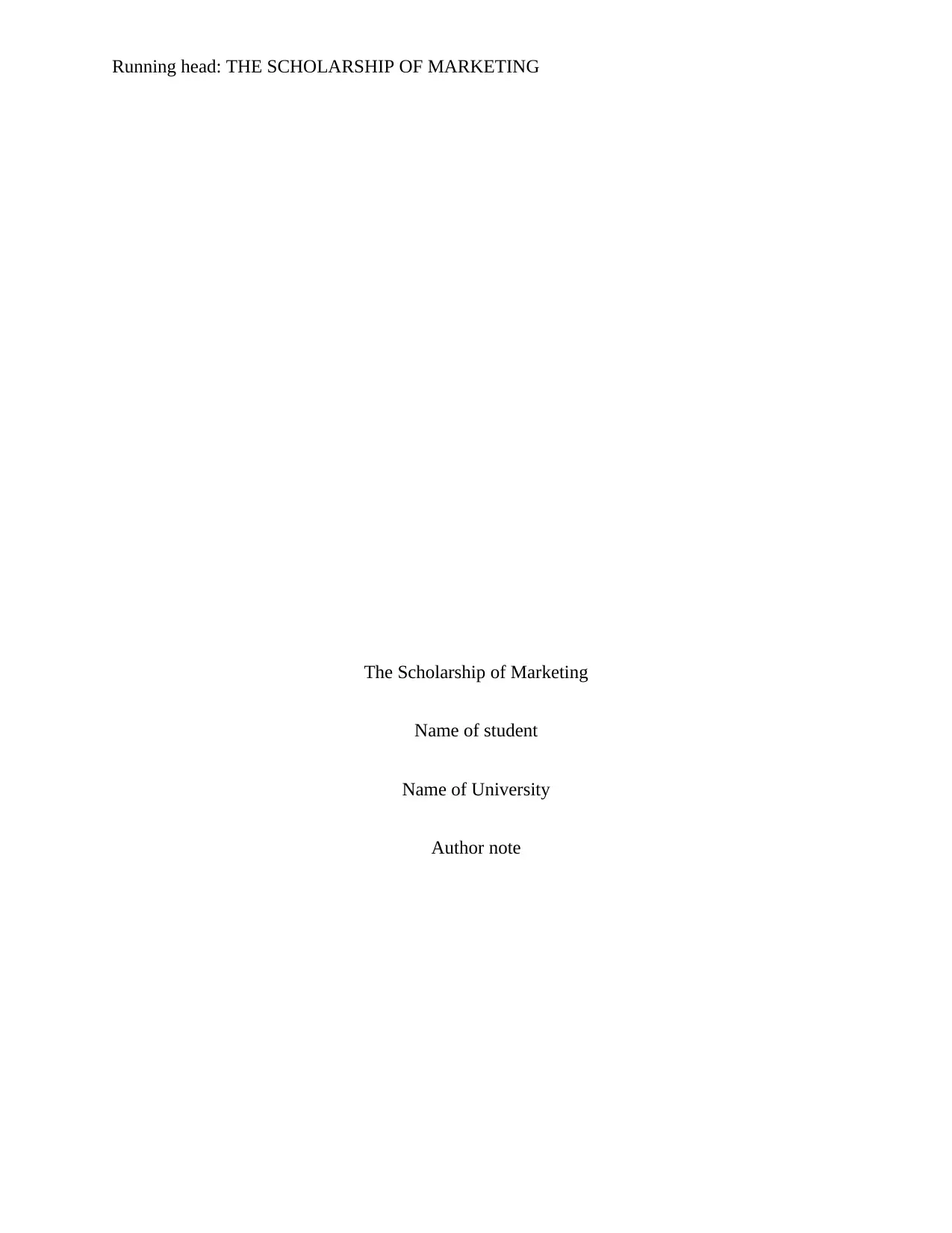
Running head: THE SCHOLARSHIP OF MARKETING
The Scholarship of Marketing
Name of student
Name of University
Author note
The Scholarship of Marketing
Name of student
Name of University
Author note
Paraphrase This Document
Need a fresh take? Get an instant paraphrase of this document with our AI Paraphraser
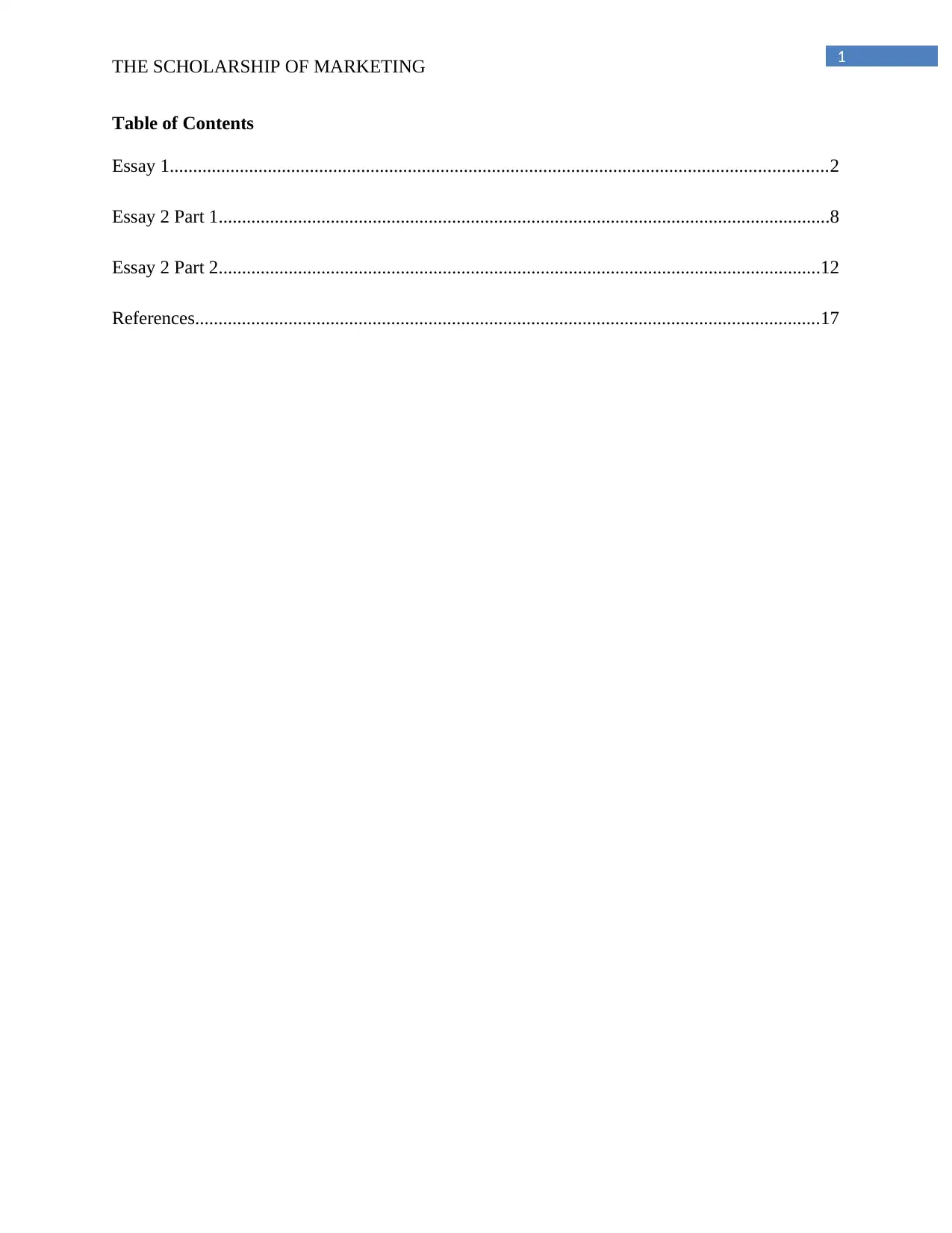
1
THE SCHOLARSHIP OF MARKETING
Table of Contents
Essay 1.............................................................................................................................................2
Essay 2 Part 1...................................................................................................................................8
Essay 2 Part 2.................................................................................................................................12
References......................................................................................................................................17
THE SCHOLARSHIP OF MARKETING
Table of Contents
Essay 1.............................................................................................................................................2
Essay 2 Part 1...................................................................................................................................8
Essay 2 Part 2.................................................................................................................................12
References......................................................................................................................................17
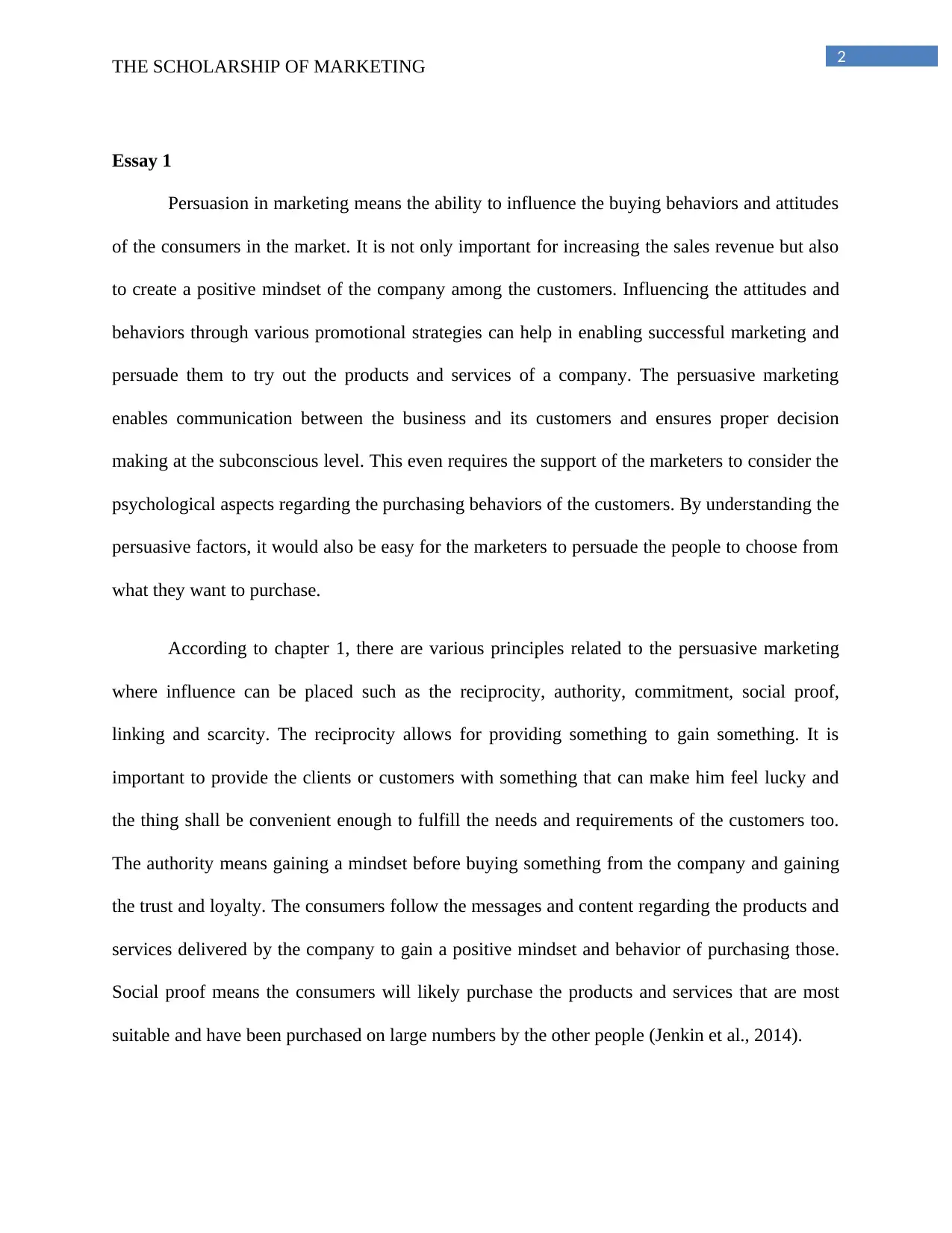
2
THE SCHOLARSHIP OF MARKETING
Essay 1
Persuasion in marketing means the ability to influence the buying behaviors and attitudes
of the consumers in the market. It is not only important for increasing the sales revenue but also
to create a positive mindset of the company among the customers. Influencing the attitudes and
behaviors through various promotional strategies can help in enabling successful marketing and
persuade them to try out the products and services of a company. The persuasive marketing
enables communication between the business and its customers and ensures proper decision
making at the subconscious level. This even requires the support of the marketers to consider the
psychological aspects regarding the purchasing behaviors of the customers. By understanding the
persuasive factors, it would also be easy for the marketers to persuade the people to choose from
what they want to purchase.
According to chapter 1, there are various principles related to the persuasive marketing
where influence can be placed such as the reciprocity, authority, commitment, social proof,
linking and scarcity. The reciprocity allows for providing something to gain something. It is
important to provide the clients or customers with something that can make him feel lucky and
the thing shall be convenient enough to fulfill the needs and requirements of the customers too.
The authority means gaining a mindset before buying something from the company and gaining
the trust and loyalty. The consumers follow the messages and content regarding the products and
services delivered by the company to gain a positive mindset and behavior of purchasing those.
Social proof means the consumers will likely purchase the products and services that are most
suitable and have been purchased on large numbers by the other people (Jenkin et al., 2014).
THE SCHOLARSHIP OF MARKETING
Essay 1
Persuasion in marketing means the ability to influence the buying behaviors and attitudes
of the consumers in the market. It is not only important for increasing the sales revenue but also
to create a positive mindset of the company among the customers. Influencing the attitudes and
behaviors through various promotional strategies can help in enabling successful marketing and
persuade them to try out the products and services of a company. The persuasive marketing
enables communication between the business and its customers and ensures proper decision
making at the subconscious level. This even requires the support of the marketers to consider the
psychological aspects regarding the purchasing behaviors of the customers. By understanding the
persuasive factors, it would also be easy for the marketers to persuade the people to choose from
what they want to purchase.
According to chapter 1, there are various principles related to the persuasive marketing
where influence can be placed such as the reciprocity, authority, commitment, social proof,
linking and scarcity. The reciprocity allows for providing something to gain something. It is
important to provide the clients or customers with something that can make him feel lucky and
the thing shall be convenient enough to fulfill the needs and requirements of the customers too.
The authority means gaining a mindset before buying something from the company and gaining
the trust and loyalty. The consumers follow the messages and content regarding the products and
services delivered by the company to gain a positive mindset and behavior of purchasing those.
Social proof means the consumers will likely purchase the products and services that are most
suitable and have been purchased on large numbers by the other people (Jenkin et al., 2014).
⊘ This is a preview!⊘
Do you want full access?
Subscribe today to unlock all pages.

Trusted by 1+ million students worldwide
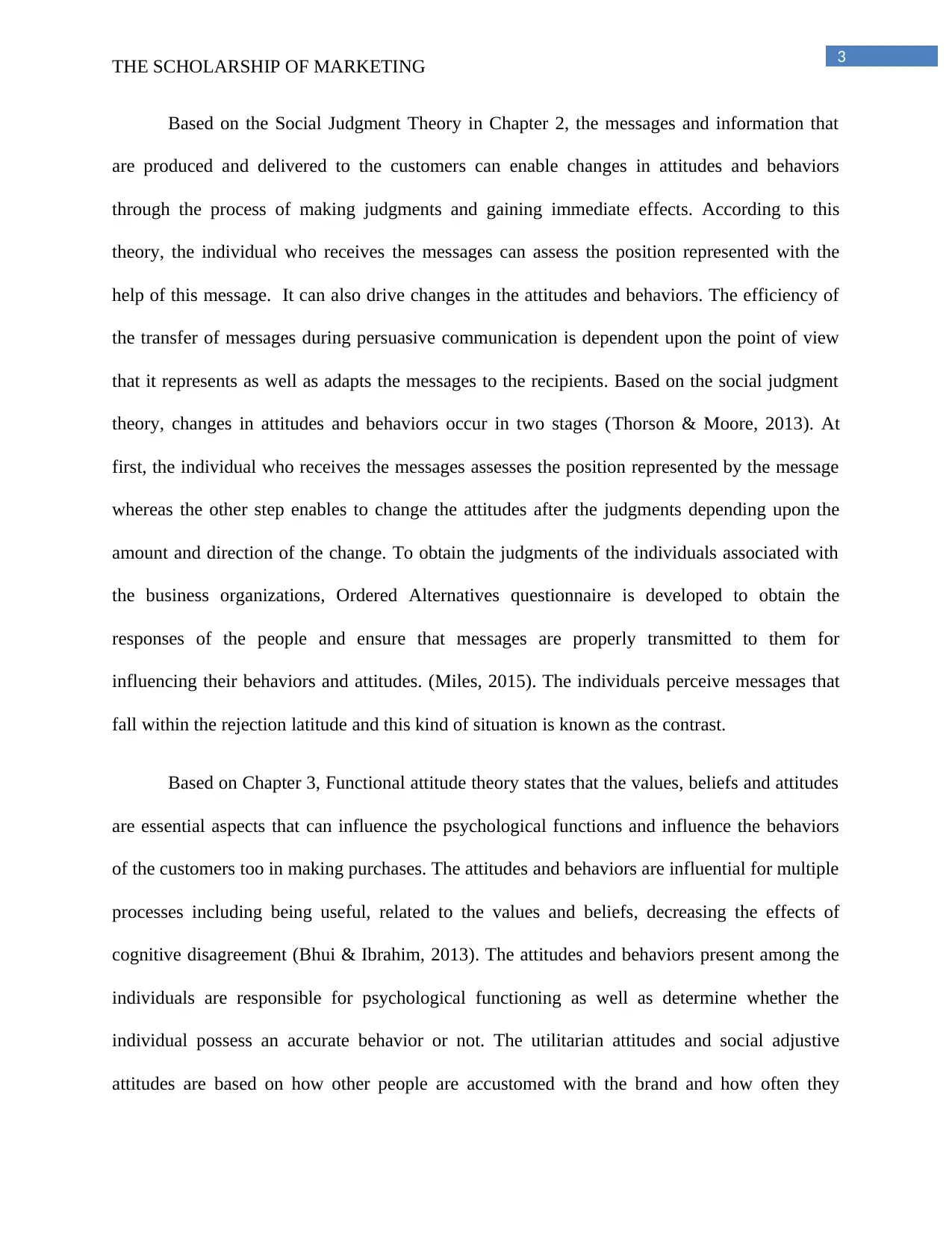
3
THE SCHOLARSHIP OF MARKETING
Based on the Social Judgment Theory in Chapter 2, the messages and information that
are produced and delivered to the customers can enable changes in attitudes and behaviors
through the process of making judgments and gaining immediate effects. According to this
theory, the individual who receives the messages can assess the position represented with the
help of this message. It can also drive changes in the attitudes and behaviors. The efficiency of
the transfer of messages during persuasive communication is dependent upon the point of view
that it represents as well as adapts the messages to the recipients. Based on the social judgment
theory, changes in attitudes and behaviors occur in two stages (Thorson & Moore, 2013). At
first, the individual who receives the messages assesses the position represented by the message
whereas the other step enables to change the attitudes after the judgments depending upon the
amount and direction of the change. To obtain the judgments of the individuals associated with
the business organizations, Ordered Alternatives questionnaire is developed to obtain the
responses of the people and ensure that messages are properly transmitted to them for
influencing their behaviors and attitudes. (Miles, 2015). The individuals perceive messages that
fall within the rejection latitude and this kind of situation is known as the contrast.
Based on Chapter 3, Functional attitude theory states that the values, beliefs and attitudes
are essential aspects that can influence the psychological functions and influence the behaviors
of the customers too in making purchases. The attitudes and behaviors are influential for multiple
processes including being useful, related to the values and beliefs, decreasing the effects of
cognitive disagreement (Bhui & Ibrahim, 2013). The attitudes and behaviors present among the
individuals are responsible for psychological functioning as well as determine whether the
individual possess an accurate behavior or not. The utilitarian attitudes and social adjustive
attitudes are based on how other people are accustomed with the brand and how often they
THE SCHOLARSHIP OF MARKETING
Based on the Social Judgment Theory in Chapter 2, the messages and information that
are produced and delivered to the customers can enable changes in attitudes and behaviors
through the process of making judgments and gaining immediate effects. According to this
theory, the individual who receives the messages can assess the position represented with the
help of this message. It can also drive changes in the attitudes and behaviors. The efficiency of
the transfer of messages during persuasive communication is dependent upon the point of view
that it represents as well as adapts the messages to the recipients. Based on the social judgment
theory, changes in attitudes and behaviors occur in two stages (Thorson & Moore, 2013). At
first, the individual who receives the messages assesses the position represented by the message
whereas the other step enables to change the attitudes after the judgments depending upon the
amount and direction of the change. To obtain the judgments of the individuals associated with
the business organizations, Ordered Alternatives questionnaire is developed to obtain the
responses of the people and ensure that messages are properly transmitted to them for
influencing their behaviors and attitudes. (Miles, 2015). The individuals perceive messages that
fall within the rejection latitude and this kind of situation is known as the contrast.
Based on Chapter 3, Functional attitude theory states that the values, beliefs and attitudes
are essential aspects that can influence the psychological functions and influence the behaviors
of the customers too in making purchases. The attitudes and behaviors are influential for multiple
processes including being useful, related to the values and beliefs, decreasing the effects of
cognitive disagreement (Bhui & Ibrahim, 2013). The attitudes and behaviors present among the
individuals are responsible for psychological functioning as well as determine whether the
individual possess an accurate behavior or not. The utilitarian attitudes and social adjustive
attitudes are based on how other people are accustomed with the brand and how often they
Paraphrase This Document
Need a fresh take? Get an instant paraphrase of this document with our AI Paraphraser
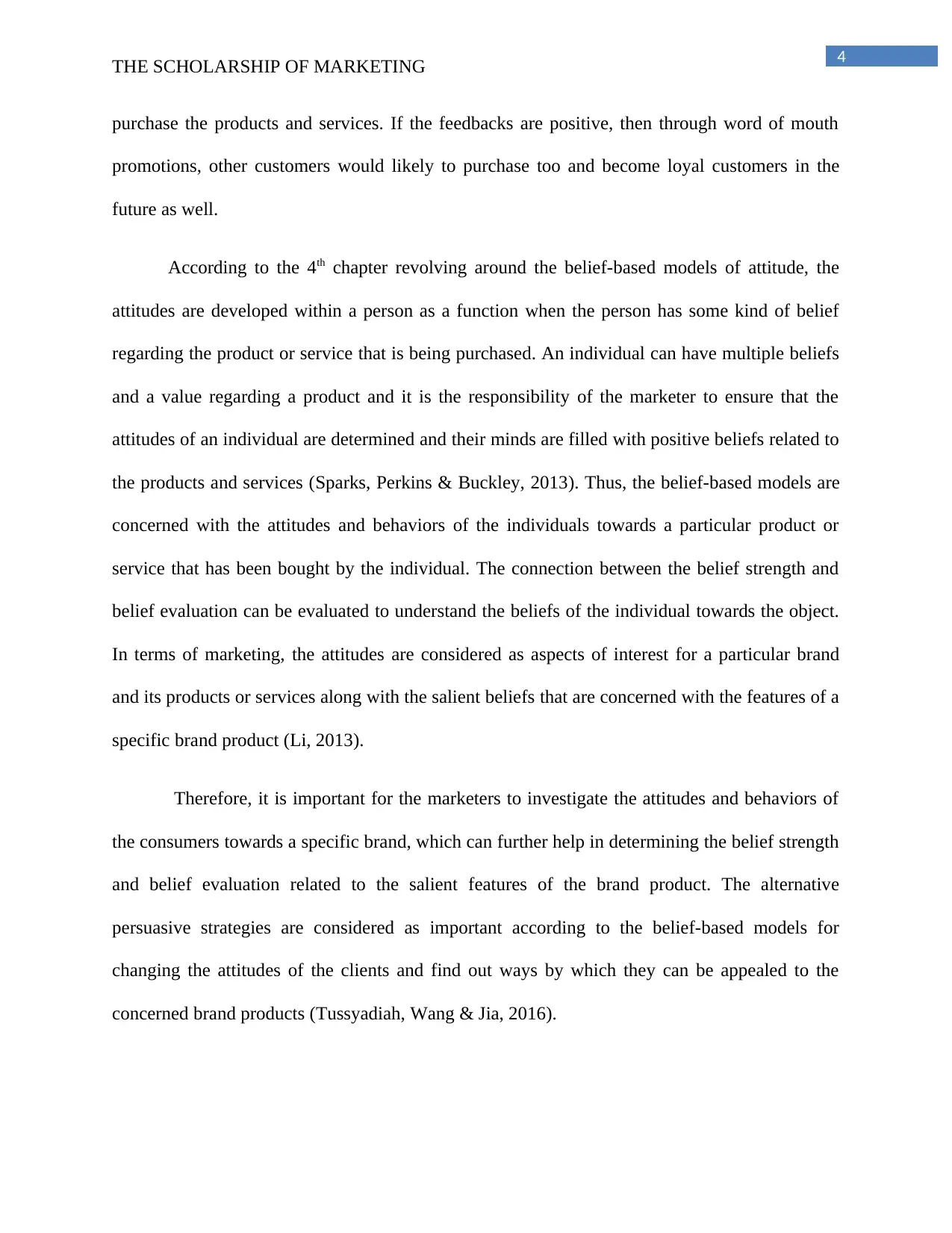
4
THE SCHOLARSHIP OF MARKETING
purchase the products and services. If the feedbacks are positive, then through word of mouth
promotions, other customers would likely to purchase too and become loyal customers in the
future as well.
According to the 4th chapter revolving around the belief-based models of attitude, the
attitudes are developed within a person as a function when the person has some kind of belief
regarding the product or service that is being purchased. An individual can have multiple beliefs
and a value regarding a product and it is the responsibility of the marketer to ensure that the
attitudes of an individual are determined and their minds are filled with positive beliefs related to
the products and services (Sparks, Perkins & Buckley, 2013). Thus, the belief-based models are
concerned with the attitudes and behaviors of the individuals towards a particular product or
service that has been bought by the individual. The connection between the belief strength and
belief evaluation can be evaluated to understand the beliefs of the individual towards the object.
In terms of marketing, the attitudes are considered as aspects of interest for a particular brand
and its products or services along with the salient beliefs that are concerned with the features of a
specific brand product (Li, 2013).
Therefore, it is important for the marketers to investigate the attitudes and behaviors of
the consumers towards a specific brand, which can further help in determining the belief strength
and belief evaluation related to the salient features of the brand product. The alternative
persuasive strategies are considered as important according to the belief-based models for
changing the attitudes of the clients and find out ways by which they can be appealed to the
concerned brand products (Tussyadiah, Wang & Jia, 2016).
THE SCHOLARSHIP OF MARKETING
purchase the products and services. If the feedbacks are positive, then through word of mouth
promotions, other customers would likely to purchase too and become loyal customers in the
future as well.
According to the 4th chapter revolving around the belief-based models of attitude, the
attitudes are developed within a person as a function when the person has some kind of belief
regarding the product or service that is being purchased. An individual can have multiple beliefs
and a value regarding a product and it is the responsibility of the marketer to ensure that the
attitudes of an individual are determined and their minds are filled with positive beliefs related to
the products and services (Sparks, Perkins & Buckley, 2013). Thus, the belief-based models are
concerned with the attitudes and behaviors of the individuals towards a particular product or
service that has been bought by the individual. The connection between the belief strength and
belief evaluation can be evaluated to understand the beliefs of the individual towards the object.
In terms of marketing, the attitudes are considered as aspects of interest for a particular brand
and its products or services along with the salient beliefs that are concerned with the features of a
specific brand product (Li, 2013).
Therefore, it is important for the marketers to investigate the attitudes and behaviors of
the consumers towards a specific brand, which can further help in determining the belief strength
and belief evaluation related to the salient features of the brand product. The alternative
persuasive strategies are considered as important according to the belief-based models for
changing the attitudes of the clients and find out ways by which they can be appealed to the
concerned brand products (Tussyadiah, Wang & Jia, 2016).
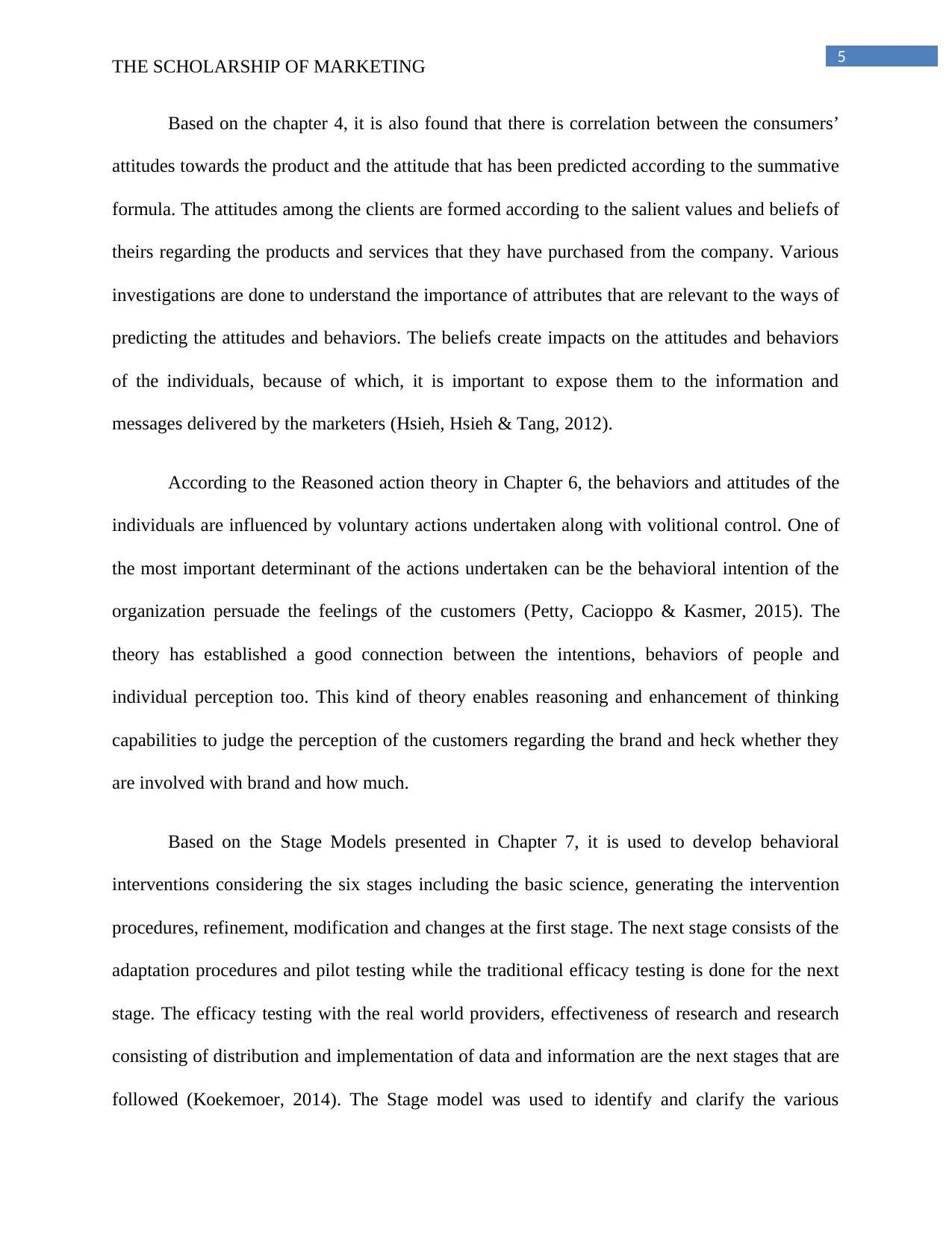
5
THE SCHOLARSHIP OF MARKETING
Based on the chapter 4, it is also found that there is correlation between the consumers’
attitudes towards the product and the attitude that has been predicted according to the summative
formula. The attitudes among the clients are formed according to the salient values and beliefs of
theirs regarding the products and services that they have purchased from the company. Various
investigations are done to understand the importance of attributes that are relevant to the ways of
predicting the attitudes and behaviors. The beliefs create impacts on the attitudes and behaviors
of the individuals, because of which, it is important to expose them to the information and
messages delivered by the marketers (Hsieh, Hsieh & Tang, 2012).
According to the Reasoned action theory in Chapter 6, the behaviors and attitudes of the
individuals are influenced by voluntary actions undertaken along with volitional control. One of
the most important determinant of the actions undertaken can be the behavioral intention of the
organization persuade the feelings of the customers (Petty, Cacioppo & Kasmer, 2015). The
theory has established a good connection between the intentions, behaviors of people and
individual perception too. This kind of theory enables reasoning and enhancement of thinking
capabilities to judge the perception of the customers regarding the brand and heck whether they
are involved with brand and how much.
Based on the Stage Models presented in Chapter 7, it is used to develop behavioral
interventions considering the six stages including the basic science, generating the intervention
procedures, refinement, modification and changes at the first stage. The next stage consists of the
adaptation procedures and pilot testing while the traditional efficacy testing is done for the next
stage. The efficacy testing with the real world providers, effectiveness of research and research
consisting of distribution and implementation of data and information are the next stages that are
followed (Koekemoer, 2014). The Stage model was used to identify and clarify the various
THE SCHOLARSHIP OF MARKETING
Based on the chapter 4, it is also found that there is correlation between the consumers’
attitudes towards the product and the attitude that has been predicted according to the summative
formula. The attitudes among the clients are formed according to the salient values and beliefs of
theirs regarding the products and services that they have purchased from the company. Various
investigations are done to understand the importance of attributes that are relevant to the ways of
predicting the attitudes and behaviors. The beliefs create impacts on the attitudes and behaviors
of the individuals, because of which, it is important to expose them to the information and
messages delivered by the marketers (Hsieh, Hsieh & Tang, 2012).
According to the Reasoned action theory in Chapter 6, the behaviors and attitudes of the
individuals are influenced by voluntary actions undertaken along with volitional control. One of
the most important determinant of the actions undertaken can be the behavioral intention of the
organization persuade the feelings of the customers (Petty, Cacioppo & Kasmer, 2015). The
theory has established a good connection between the intentions, behaviors of people and
individual perception too. This kind of theory enables reasoning and enhancement of thinking
capabilities to judge the perception of the customers regarding the brand and heck whether they
are involved with brand and how much.
Based on the Stage Models presented in Chapter 7, it is used to develop behavioral
interventions considering the six stages including the basic science, generating the intervention
procedures, refinement, modification and changes at the first stage. The next stage consists of the
adaptation procedures and pilot testing while the traditional efficacy testing is done for the next
stage. The efficacy testing with the real world providers, effectiveness of research and research
consisting of distribution and implementation of data and information are the next stages that are
followed (Koekemoer, 2014). The Stage model was used to identify and clarify the various
⊘ This is a preview!⊘
Do you want full access?
Subscribe today to unlock all pages.

Trusted by 1+ million students worldwide
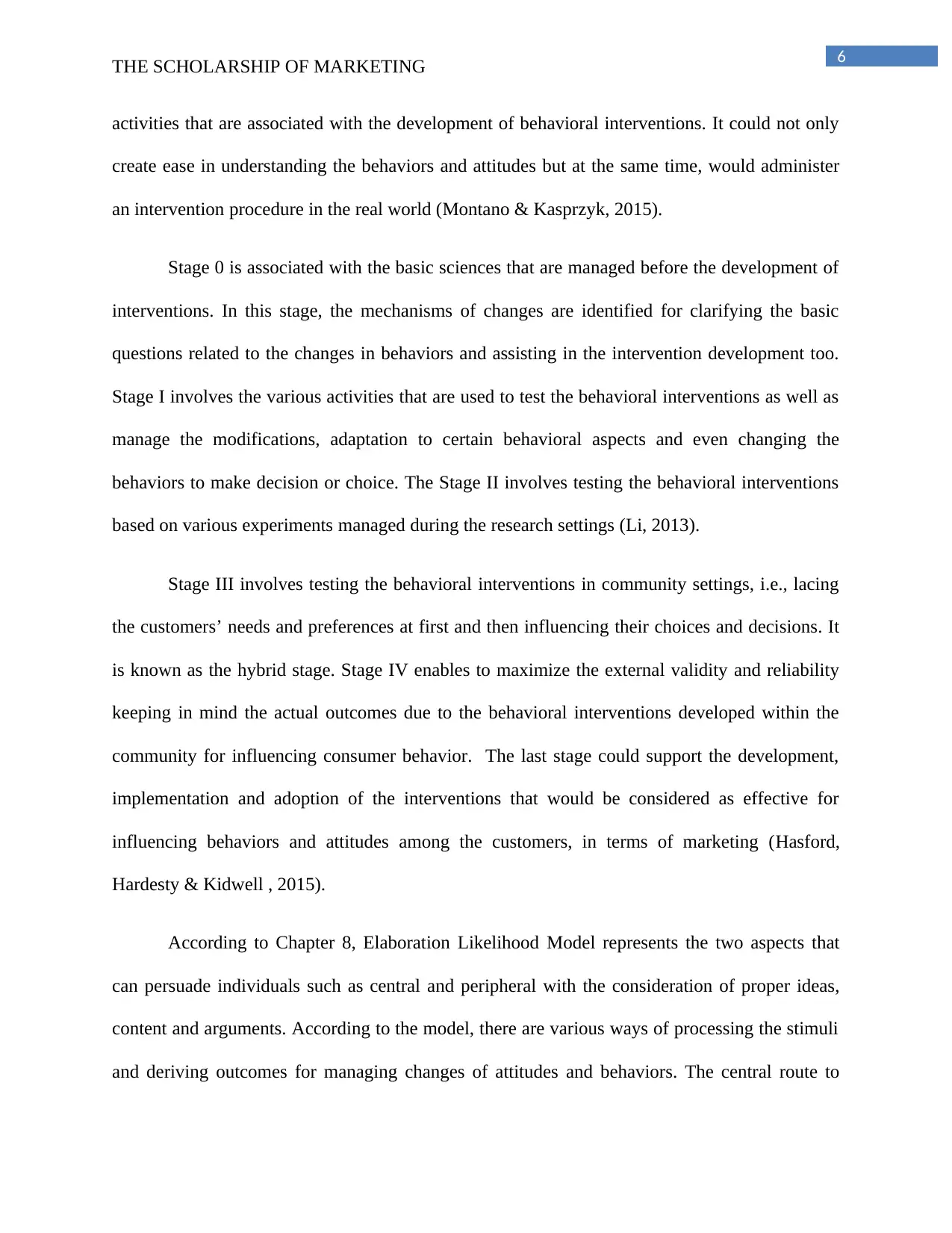
6
THE SCHOLARSHIP OF MARKETING
activities that are associated with the development of behavioral interventions. It could not only
create ease in understanding the behaviors and attitudes but at the same time, would administer
an intervention procedure in the real world (Montano & Kasprzyk, 2015).
Stage 0 is associated with the basic sciences that are managed before the development of
interventions. In this stage, the mechanisms of changes are identified for clarifying the basic
questions related to the changes in behaviors and assisting in the intervention development too.
Stage I involves the various activities that are used to test the behavioral interventions as well as
manage the modifications, adaptation to certain behavioral aspects and even changing the
behaviors to make decision or choice. The Stage II involves testing the behavioral interventions
based on various experiments managed during the research settings (Li, 2013).
Stage III involves testing the behavioral interventions in community settings, i.e., lacing
the customers’ needs and preferences at first and then influencing their choices and decisions. It
is known as the hybrid stage. Stage IV enables to maximize the external validity and reliability
keeping in mind the actual outcomes due to the behavioral interventions developed within the
community for influencing consumer behavior. The last stage could support the development,
implementation and adoption of the interventions that would be considered as effective for
influencing behaviors and attitudes among the customers, in terms of marketing (Hasford,
Hardesty & Kidwell , 2015).
According to Chapter 8, Elaboration Likelihood Model represents the two aspects that
can persuade individuals such as central and peripheral with the consideration of proper ideas,
content and arguments. According to the model, there are various ways of processing the stimuli
and deriving outcomes for managing changes of attitudes and behaviors. The central route to
THE SCHOLARSHIP OF MARKETING
activities that are associated with the development of behavioral interventions. It could not only
create ease in understanding the behaviors and attitudes but at the same time, would administer
an intervention procedure in the real world (Montano & Kasprzyk, 2015).
Stage 0 is associated with the basic sciences that are managed before the development of
interventions. In this stage, the mechanisms of changes are identified for clarifying the basic
questions related to the changes in behaviors and assisting in the intervention development too.
Stage I involves the various activities that are used to test the behavioral interventions as well as
manage the modifications, adaptation to certain behavioral aspects and even changing the
behaviors to make decision or choice. The Stage II involves testing the behavioral interventions
based on various experiments managed during the research settings (Li, 2013).
Stage III involves testing the behavioral interventions in community settings, i.e., lacing
the customers’ needs and preferences at first and then influencing their choices and decisions. It
is known as the hybrid stage. Stage IV enables to maximize the external validity and reliability
keeping in mind the actual outcomes due to the behavioral interventions developed within the
community for influencing consumer behavior. The last stage could support the development,
implementation and adoption of the interventions that would be considered as effective for
influencing behaviors and attitudes among the customers, in terms of marketing (Hasford,
Hardesty & Kidwell , 2015).
According to Chapter 8, Elaboration Likelihood Model represents the two aspects that
can persuade individuals such as central and peripheral with the consideration of proper ideas,
content and arguments. According to the model, there are various ways of processing the stimuli
and deriving outcomes for managing changes of attitudes and behaviors. The central route to
Paraphrase This Document
Need a fresh take? Get an instant paraphrase of this document with our AI Paraphraser
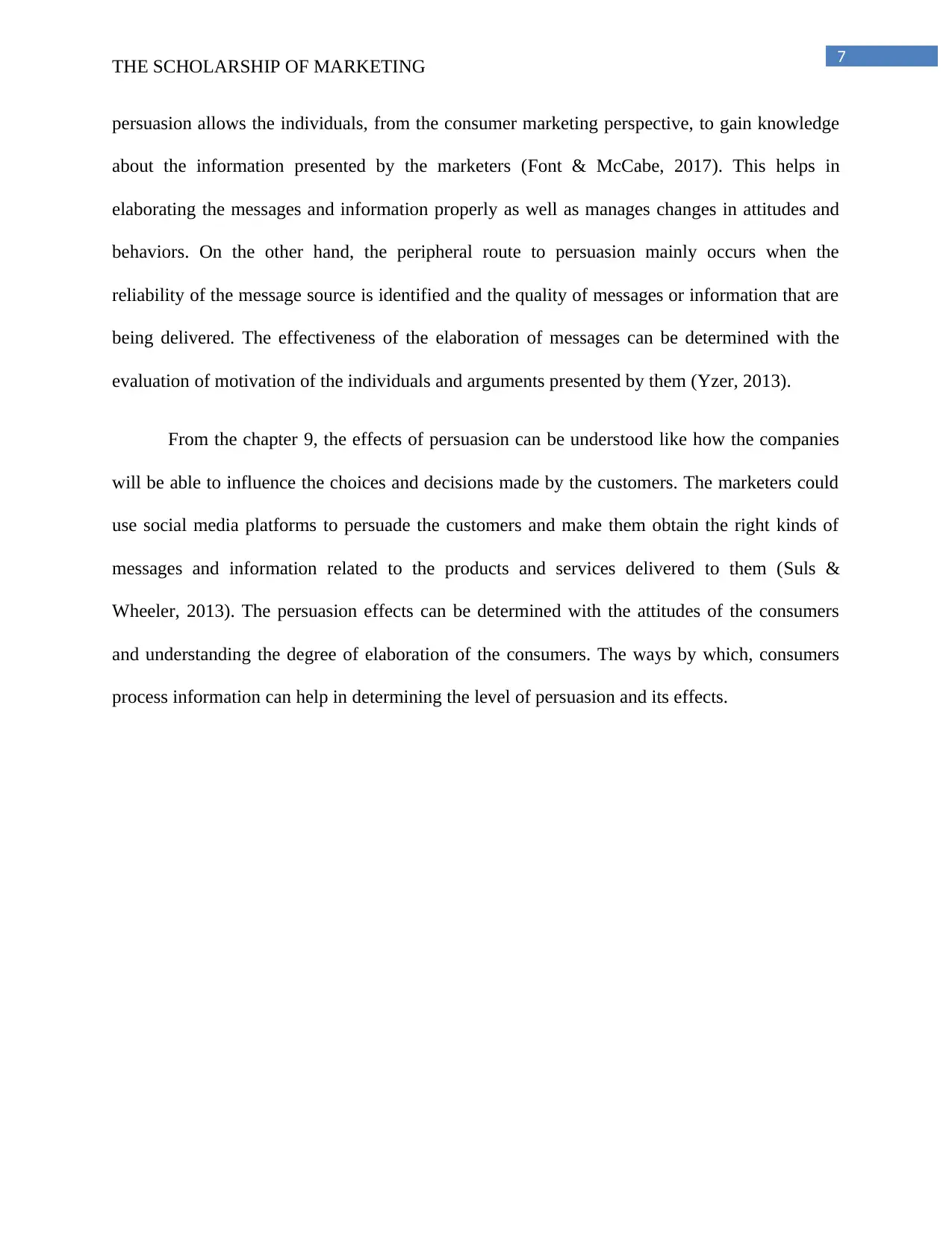
7
THE SCHOLARSHIP OF MARKETING
persuasion allows the individuals, from the consumer marketing perspective, to gain knowledge
about the information presented by the marketers (Font & McCabe, 2017). This helps in
elaborating the messages and information properly as well as manages changes in attitudes and
behaviors. On the other hand, the peripheral route to persuasion mainly occurs when the
reliability of the message source is identified and the quality of messages or information that are
being delivered. The effectiveness of the elaboration of messages can be determined with the
evaluation of motivation of the individuals and arguments presented by them (Yzer, 2013).
From the chapter 9, the effects of persuasion can be understood like how the companies
will be able to influence the choices and decisions made by the customers. The marketers could
use social media platforms to persuade the customers and make them obtain the right kinds of
messages and information related to the products and services delivered to them (Suls &
Wheeler, 2013). The persuasion effects can be determined with the attitudes of the consumers
and understanding the degree of elaboration of the consumers. The ways by which, consumers
process information can help in determining the level of persuasion and its effects.
THE SCHOLARSHIP OF MARKETING
persuasion allows the individuals, from the consumer marketing perspective, to gain knowledge
about the information presented by the marketers (Font & McCabe, 2017). This helps in
elaborating the messages and information properly as well as manages changes in attitudes and
behaviors. On the other hand, the peripheral route to persuasion mainly occurs when the
reliability of the message source is identified and the quality of messages or information that are
being delivered. The effectiveness of the elaboration of messages can be determined with the
evaluation of motivation of the individuals and arguments presented by them (Yzer, 2013).
From the chapter 9, the effects of persuasion can be understood like how the companies
will be able to influence the choices and decisions made by the customers. The marketers could
use social media platforms to persuade the customers and make them obtain the right kinds of
messages and information related to the products and services delivered to them (Suls &
Wheeler, 2013). The persuasion effects can be determined with the attitudes of the consumers
and understanding the degree of elaboration of the consumers. The ways by which, consumers
process information can help in determining the level of persuasion and its effects.
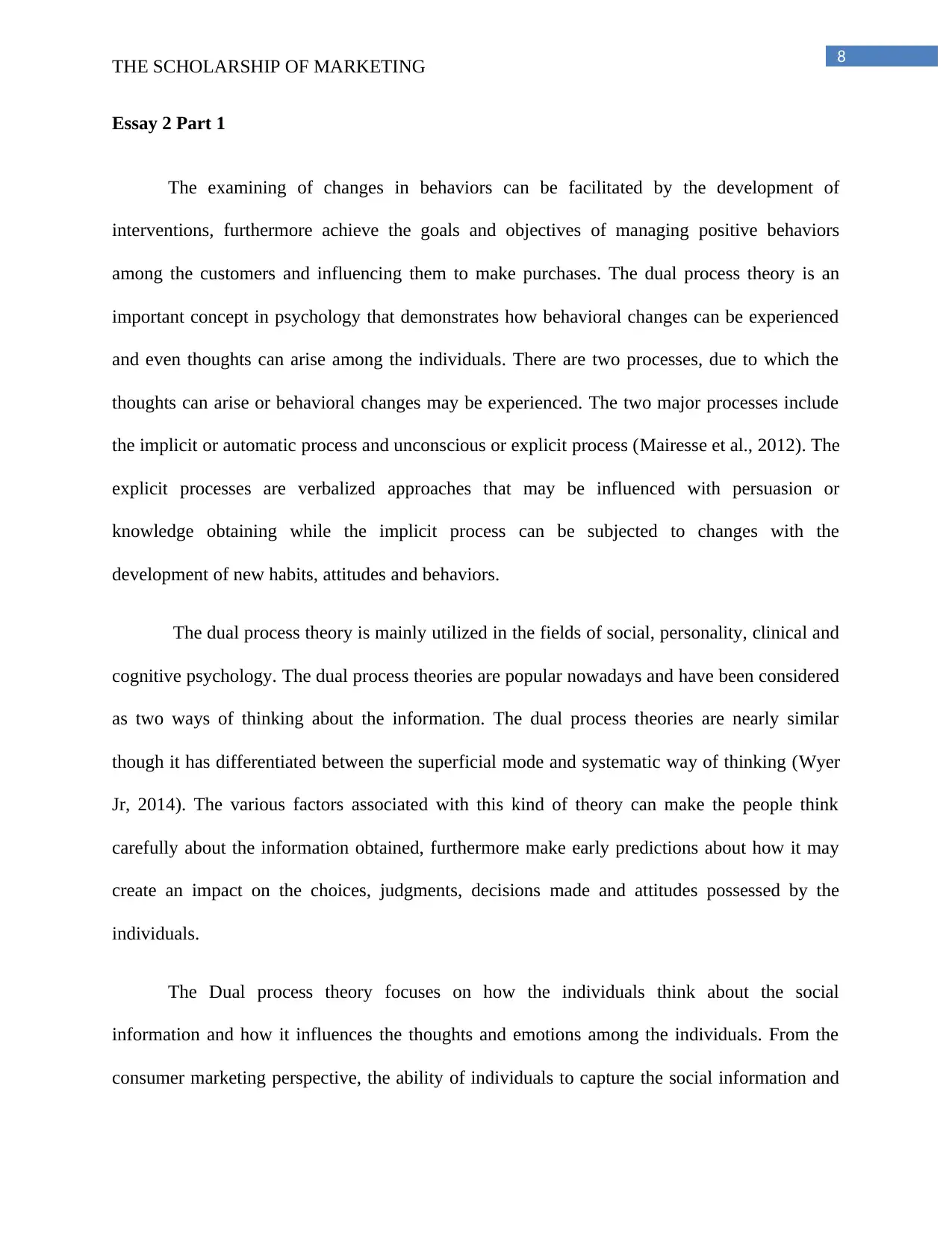
8
THE SCHOLARSHIP OF MARKETING
Essay 2 Part 1
The examining of changes in behaviors can be facilitated by the development of
interventions, furthermore achieve the goals and objectives of managing positive behaviors
among the customers and influencing them to make purchases. The dual process theory is an
important concept in psychology that demonstrates how behavioral changes can be experienced
and even thoughts can arise among the individuals. There are two processes, due to which the
thoughts can arise or behavioral changes may be experienced. The two major processes include
the implicit or automatic process and unconscious or explicit process (Mairesse et al., 2012). The
explicit processes are verbalized approaches that may be influenced with persuasion or
knowledge obtaining while the implicit process can be subjected to changes with the
development of new habits, attitudes and behaviors.
The dual process theory is mainly utilized in the fields of social, personality, clinical and
cognitive psychology. The dual process theories are popular nowadays and have been considered
as two ways of thinking about the information. The dual process theories are nearly similar
though it has differentiated between the superficial mode and systematic way of thinking (Wyer
Jr, 2014). The various factors associated with this kind of theory can make the people think
carefully about the information obtained, furthermore make early predictions about how it may
create an impact on the choices, judgments, decisions made and attitudes possessed by the
individuals.
The Dual process theory focuses on how the individuals think about the social
information and how it influences the thoughts and emotions among the individuals. From the
consumer marketing perspective, the ability of individuals to capture the social information and
THE SCHOLARSHIP OF MARKETING
Essay 2 Part 1
The examining of changes in behaviors can be facilitated by the development of
interventions, furthermore achieve the goals and objectives of managing positive behaviors
among the customers and influencing them to make purchases. The dual process theory is an
important concept in psychology that demonstrates how behavioral changes can be experienced
and even thoughts can arise among the individuals. There are two processes, due to which the
thoughts can arise or behavioral changes may be experienced. The two major processes include
the implicit or automatic process and unconscious or explicit process (Mairesse et al., 2012). The
explicit processes are verbalized approaches that may be influenced with persuasion or
knowledge obtaining while the implicit process can be subjected to changes with the
development of new habits, attitudes and behaviors.
The dual process theory is mainly utilized in the fields of social, personality, clinical and
cognitive psychology. The dual process theories are popular nowadays and have been considered
as two ways of thinking about the information. The dual process theories are nearly similar
though it has differentiated between the superficial mode and systematic way of thinking (Wyer
Jr, 2014). The various factors associated with this kind of theory can make the people think
carefully about the information obtained, furthermore make early predictions about how it may
create an impact on the choices, judgments, decisions made and attitudes possessed by the
individuals.
The Dual process theory focuses on how the individuals think about the social
information and how it influences the thoughts and emotions among the individuals. From the
consumer marketing perspective, the ability of individuals to capture the social information and
⊘ This is a preview!⊘
Do you want full access?
Subscribe today to unlock all pages.

Trusted by 1+ million students worldwide
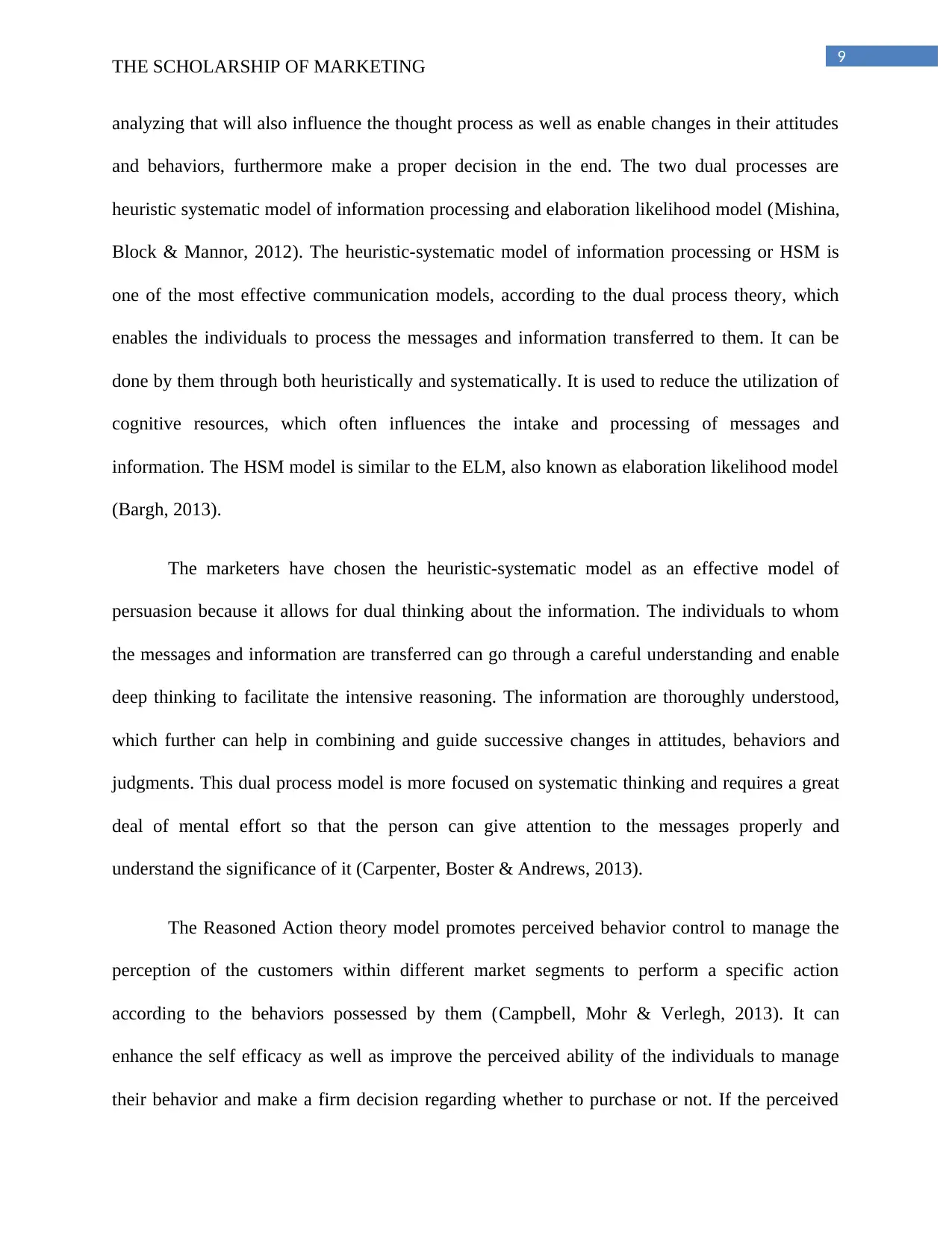
9
THE SCHOLARSHIP OF MARKETING
analyzing that will also influence the thought process as well as enable changes in their attitudes
and behaviors, furthermore make a proper decision in the end. The two dual processes are
heuristic systematic model of information processing and elaboration likelihood model (Mishina,
Block & Mannor, 2012). The heuristic-systematic model of information processing or HSM is
one of the most effective communication models, according to the dual process theory, which
enables the individuals to process the messages and information transferred to them. It can be
done by them through both heuristically and systematically. It is used to reduce the utilization of
cognitive resources, which often influences the intake and processing of messages and
information. The HSM model is similar to the ELM, also known as elaboration likelihood model
(Bargh, 2013).
The marketers have chosen the heuristic-systematic model as an effective model of
persuasion because it allows for dual thinking about the information. The individuals to whom
the messages and information are transferred can go through a careful understanding and enable
deep thinking to facilitate the intensive reasoning. The information are thoroughly understood,
which further can help in combining and guide successive changes in attitudes, behaviors and
judgments. This dual process model is more focused on systematic thinking and requires a great
deal of mental effort so that the person can give attention to the messages properly and
understand the significance of it (Carpenter, Boster & Andrews, 2013).
The Reasoned Action theory model promotes perceived behavior control to manage the
perception of the customers within different market segments to perform a specific action
according to the behaviors possessed by them (Campbell, Mohr & Verlegh, 2013). It can
enhance the self efficacy as well as improve the perceived ability of the individuals to manage
their behavior and make a firm decision regarding whether to purchase or not. If the perceived
THE SCHOLARSHIP OF MARKETING
analyzing that will also influence the thought process as well as enable changes in their attitudes
and behaviors, furthermore make a proper decision in the end. The two dual processes are
heuristic systematic model of information processing and elaboration likelihood model (Mishina,
Block & Mannor, 2012). The heuristic-systematic model of information processing or HSM is
one of the most effective communication models, according to the dual process theory, which
enables the individuals to process the messages and information transferred to them. It can be
done by them through both heuristically and systematically. It is used to reduce the utilization of
cognitive resources, which often influences the intake and processing of messages and
information. The HSM model is similar to the ELM, also known as elaboration likelihood model
(Bargh, 2013).
The marketers have chosen the heuristic-systematic model as an effective model of
persuasion because it allows for dual thinking about the information. The individuals to whom
the messages and information are transferred can go through a careful understanding and enable
deep thinking to facilitate the intensive reasoning. The information are thoroughly understood,
which further can help in combining and guide successive changes in attitudes, behaviors and
judgments. This dual process model is more focused on systematic thinking and requires a great
deal of mental effort so that the person can give attention to the messages properly and
understand the significance of it (Carpenter, Boster & Andrews, 2013).
The Reasoned Action theory model promotes perceived behavior control to manage the
perception of the customers within different market segments to perform a specific action
according to the behaviors possessed by them (Campbell, Mohr & Verlegh, 2013). It can
enhance the self efficacy as well as improve the perceived ability of the individuals to manage
their behavior and make a firm decision regarding whether to purchase or not. If the perceived
Paraphrase This Document
Need a fresh take? Get an instant paraphrase of this document with our AI Paraphraser
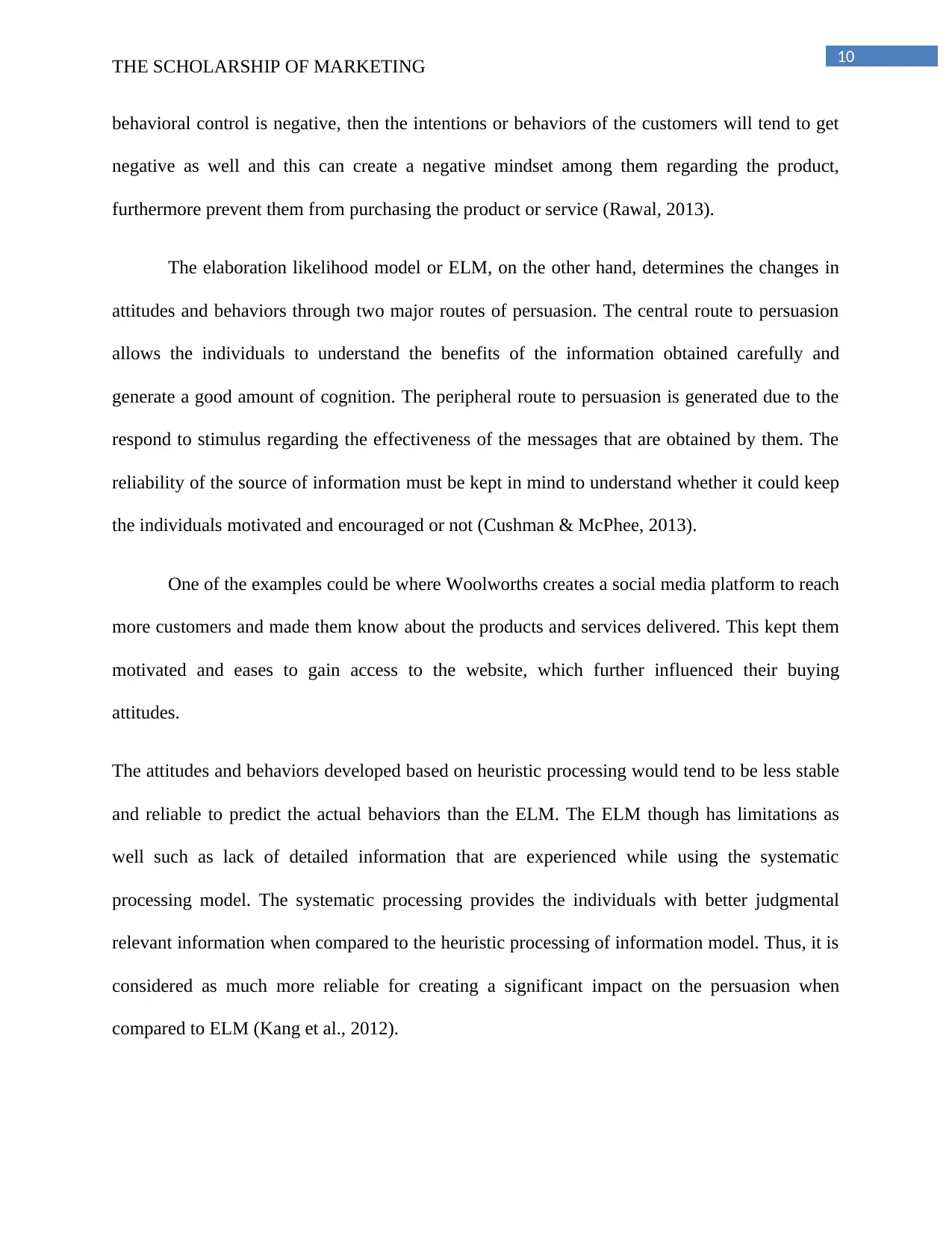
10
THE SCHOLARSHIP OF MARKETING
behavioral control is negative, then the intentions or behaviors of the customers will tend to get
negative as well and this can create a negative mindset among them regarding the product,
furthermore prevent them from purchasing the product or service (Rawal, 2013).
The elaboration likelihood model or ELM, on the other hand, determines the changes in
attitudes and behaviors through two major routes of persuasion. The central route to persuasion
allows the individuals to understand the benefits of the information obtained carefully and
generate a good amount of cognition. The peripheral route to persuasion is generated due to the
respond to stimulus regarding the effectiveness of the messages that are obtained by them. The
reliability of the source of information must be kept in mind to understand whether it could keep
the individuals motivated and encouraged or not (Cushman & McPhee, 2013).
One of the examples could be where Woolworths creates a social media platform to reach
more customers and made them know about the products and services delivered. This kept them
motivated and eases to gain access to the website, which further influenced their buying
attitudes.
The attitudes and behaviors developed based on heuristic processing would tend to be less stable
and reliable to predict the actual behaviors than the ELM. The ELM though has limitations as
well such as lack of detailed information that are experienced while using the systematic
processing model. The systematic processing provides the individuals with better judgmental
relevant information when compared to the heuristic processing of information model. Thus, it is
considered as much more reliable for creating a significant impact on the persuasion when
compared to ELM (Kang et al., 2012).
THE SCHOLARSHIP OF MARKETING
behavioral control is negative, then the intentions or behaviors of the customers will tend to get
negative as well and this can create a negative mindset among them regarding the product,
furthermore prevent them from purchasing the product or service (Rawal, 2013).
The elaboration likelihood model or ELM, on the other hand, determines the changes in
attitudes and behaviors through two major routes of persuasion. The central route to persuasion
allows the individuals to understand the benefits of the information obtained carefully and
generate a good amount of cognition. The peripheral route to persuasion is generated due to the
respond to stimulus regarding the effectiveness of the messages that are obtained by them. The
reliability of the source of information must be kept in mind to understand whether it could keep
the individuals motivated and encouraged or not (Cushman & McPhee, 2013).
One of the examples could be where Woolworths creates a social media platform to reach
more customers and made them know about the products and services delivered. This kept them
motivated and eases to gain access to the website, which further influenced their buying
attitudes.
The attitudes and behaviors developed based on heuristic processing would tend to be less stable
and reliable to predict the actual behaviors than the ELM. The ELM though has limitations as
well such as lack of detailed information that are experienced while using the systematic
processing model. The systematic processing provides the individuals with better judgmental
relevant information when compared to the heuristic processing of information model. Thus, it is
considered as much more reliable for creating a significant impact on the persuasion when
compared to ELM (Kang et al., 2012).
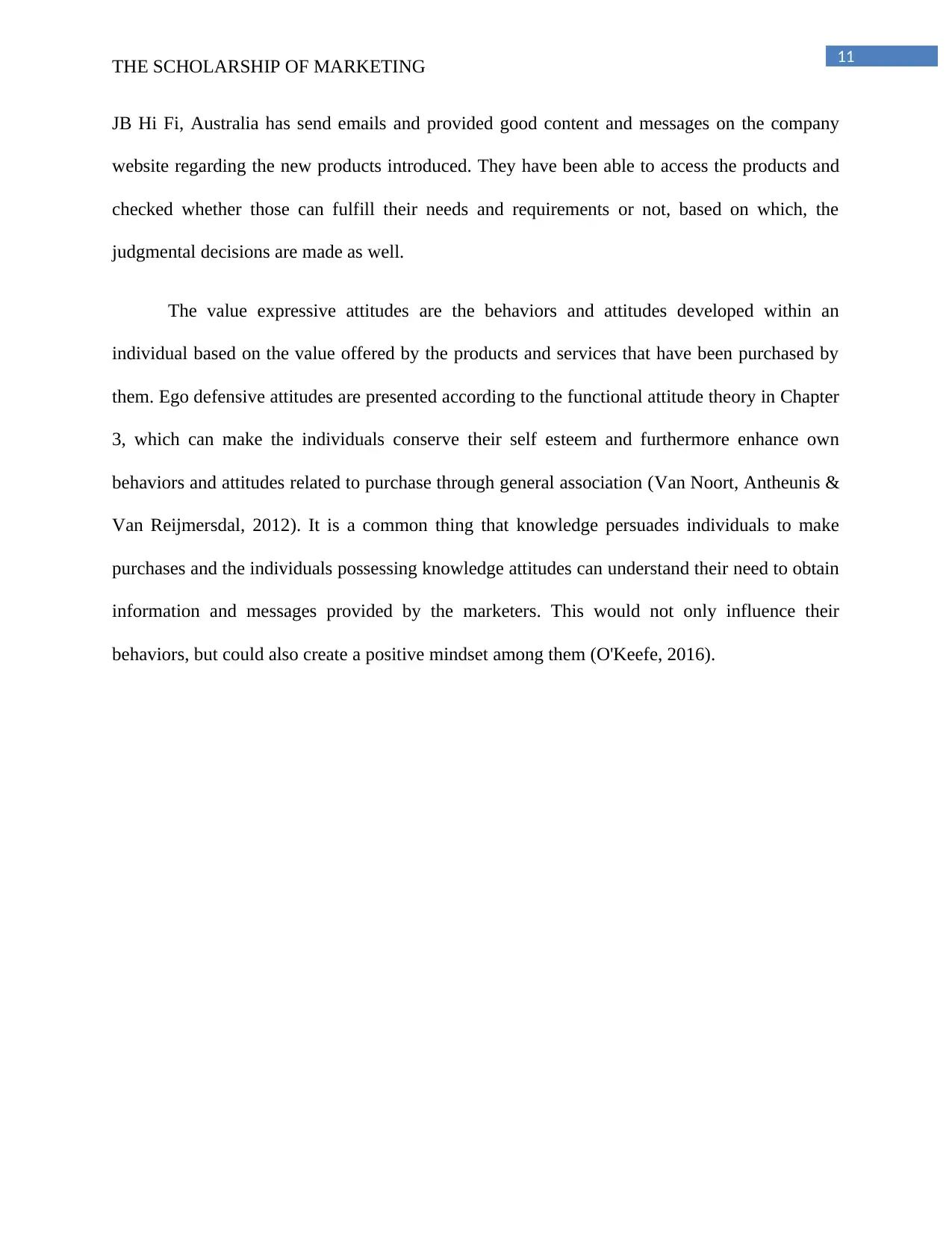
11
THE SCHOLARSHIP OF MARKETING
JB Hi Fi, Australia has send emails and provided good content and messages on the company
website regarding the new products introduced. They have been able to access the products and
checked whether those can fulfill their needs and requirements or not, based on which, the
judgmental decisions are made as well.
The value expressive attitudes are the behaviors and attitudes developed within an
individual based on the value offered by the products and services that have been purchased by
them. Ego defensive attitudes are presented according to the functional attitude theory in Chapter
3, which can make the individuals conserve their self esteem and furthermore enhance own
behaviors and attitudes related to purchase through general association (Van Noort, Antheunis &
Van Reijmersdal, 2012). It is a common thing that knowledge persuades individuals to make
purchases and the individuals possessing knowledge attitudes can understand their need to obtain
information and messages provided by the marketers. This would not only influence their
behaviors, but could also create a positive mindset among them (O'Keefe, 2016).
THE SCHOLARSHIP OF MARKETING
JB Hi Fi, Australia has send emails and provided good content and messages on the company
website regarding the new products introduced. They have been able to access the products and
checked whether those can fulfill their needs and requirements or not, based on which, the
judgmental decisions are made as well.
The value expressive attitudes are the behaviors and attitudes developed within an
individual based on the value offered by the products and services that have been purchased by
them. Ego defensive attitudes are presented according to the functional attitude theory in Chapter
3, which can make the individuals conserve their self esteem and furthermore enhance own
behaviors and attitudes related to purchase through general association (Van Noort, Antheunis &
Van Reijmersdal, 2012). It is a common thing that knowledge persuades individuals to make
purchases and the individuals possessing knowledge attitudes can understand their need to obtain
information and messages provided by the marketers. This would not only influence their
behaviors, but could also create a positive mindset among them (O'Keefe, 2016).
⊘ This is a preview!⊘
Do you want full access?
Subscribe today to unlock all pages.

Trusted by 1+ million students worldwide
1 out of 21
Related Documents
Your All-in-One AI-Powered Toolkit for Academic Success.
+13062052269
info@desklib.com
Available 24*7 on WhatsApp / Email
![[object Object]](/_next/static/media/star-bottom.7253800d.svg)
Unlock your academic potential
Copyright © 2020–2025 A2Z Services. All Rights Reserved. Developed and managed by ZUCOL.





